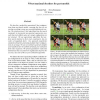Free Online Productivity Tools
i2Speak
i2Symbol
i2OCR
iTex2Img
iWeb2Print
iWeb2Shot
i2Type
iPdf2Split
iPdf2Merge
i2Bopomofo
i2Arabic
i2Style
i2Image
i2PDF
iLatex2Rtf
Sci2ools
ICCV
2011
IEEE
2011
IEEE
N-best maximal decoders for part models
We describe a method for generating N-best configurations from part-based models, ensuring that they do not overlap according to some user-provided definition of overlap. We extend previous N-best algorithms from the speech community to incorporate non-maximal suppression cues, such that pixel-shifted copies of a single configuration are not returned. We use approximate algorithms that perform nearly identical to their exact counterparts, but are orders of magnitude faster. Our approach outperforms standard methods for generating multiple object configurations in an image. We use our method to generate multiple pose hypotheses for the problem of human pose estimation from video sequences. We present quantitative results that demonstrate that our framework significantly improves the accuracy of a state-of-the-art pose estimation algorithm. We address the task of generating multiple candidate object configurations in an image or video, within the framework of part-based models. Su...
| Added | 11 Dec 2011 |
| Updated | 11 Dec 2011 |
| Type | Journal |
| Year | 2011 |
| Where | ICCV |
| Authors | Dennis Park, Deva Ramanan |
Comments (0)

